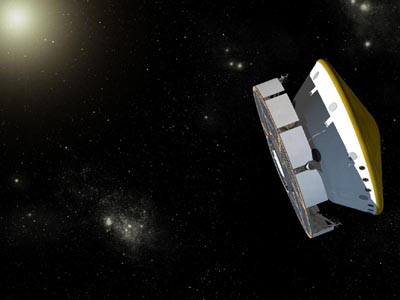The payload fairing protecting NASA's Mars Science Laboratory (MSL) standing atop the United Launch Alliance Atlas V rocket before the spacecraft's launch on 26 November last. Image credit: NASA
NASA’s Mars Science Laboratory spacecraft Curiosity looks set to perform what the space agency is calling its “biggest manoeuvre” yet when it undergoes an engine firing tomorrow, 11 January, to help it line up with Mars as part of its flight mission to the Red Planet.
The Curiosity rover, which set off on 26 November 2011 towards Mars for an August 2012 landing date at Gale Crater, is using the stars to navigate its flight path.
Arthur Amador, Mars Science Laboratory cruise mission manager at NASA’s Jet Propulsion Laboratory in Pasadena, California, said the action tomorrow will involve a choreographed sequence of firings of eight thruster engines.
The firings will take place over a 175-minute period, beginning at 6pm EST (3pm PST, or 11pm Universal Time).
NASA has indicated that the firings will redirect the spacecraft more precisely toward Mars. The manoeuvre will aim to impart a velocity change of about 12.3 miles per hour (5.5 metres per second).
Interestingly, the current path of Curiosity intentionally misses Mars. NASA has said this is to prevent the upper stage of the launch vehicle from hitting the planet.
As part of this, before the launch, NASA did not clean the upper stage of the spacecraft the way the spacecraft itself was in order to protect Mars from Earth’s microbes.
NASA’s Curiosity rover

Artist’s concept of the Mars Science Laboratory spacecraft during its cruise phase between launch and final approach to Mars. Image by NASA/JPL-Caltech
“We are well into cruise operations, with a well-behaved spacecraft safely on its way to Mars,” said Amadeur at NASA this week.
“After this trajectory correction manoeuvre, we expect to be very close to where we ultimately need to be for our entry point at the top of the Martian atmosphere,” he said.
Before the spacecraft’s scheduled arrival at Mars on 5 August (PDT) next (6 August, Universal Time and EDT), NASA is allowing for five more flight path correction manoeuvres to fine tune the flight path.
Once on Mars, the Mars Science Laboratory mission will use its car-size rover, Curiosity, to investigate whether the selected region on Mars inside Gale Crater has offered environmental conditions that could have been favourable for supporting microbial life, as well as potentially offering clues about whether life ever existed on the planet.
More on the spacecraft:
- Its cruise-stage solar array is producing 780 watts.
- The telecommunications rate is 2 kilobits per second for uplink and downlink. The spacecraft is spinning at 2.04 rotations per minute.
- The Radiation Assessment Detector, one of 10 science instruments on the rover, is collecting science data about the interplanetary radiation environment.
The Jet Propulsion laboratory, a division of California Institute of Technology in Pasadena, is managing the Mars Science Laboratory mission.